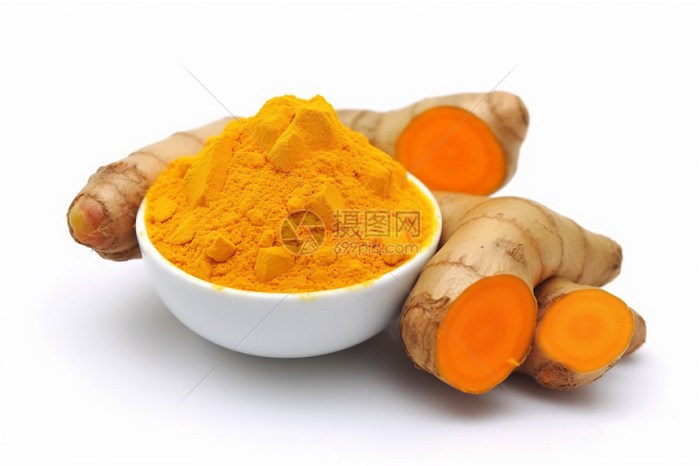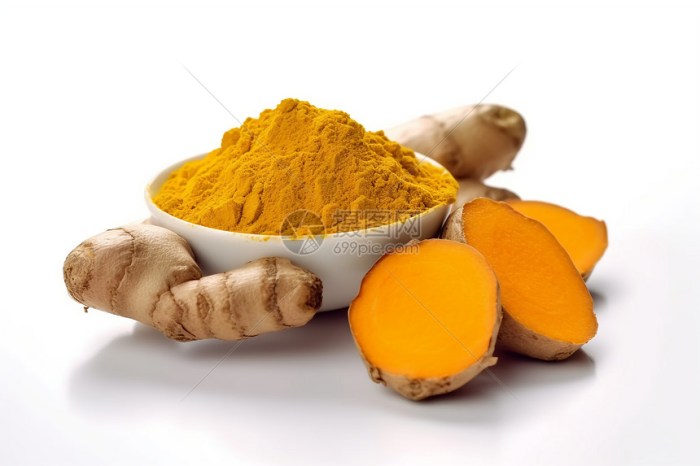Turmeric health benefits for women are plentiful and fascinating, offering a natural approach to overall well-being. From hormonal balance to digestive health, bone strength, skin radiance, and immune support, turmeric’s active compound, curcumin, appears to play a key role in various aspects of women’s health. This exploration delves into the science behind turmeric’s effects, highlighting potential benefits, safe consumption practices, and practical ways to incorporate this vibrant spice into your daily life.
This comprehensive guide will cover the historical use of turmeric, its potential impact on hormonal regulation, digestive health, bone health, skin health, and immune function in women. We’ll also examine safety considerations and provide delicious recipes to help you easily incorporate this powerful spice into your diet.
Introduction to Turmeric and Women’s Health
Turmeric, a vibrant yellow spice, has been a cornerstone of Ayurvedic medicine and various culinary traditions for centuries. Its use stretches back through history, prized not only for its flavour but also for its potential health benefits. From vibrant curry dishes to traditional remedies, turmeric’s presence speaks volumes about its cultural significance. Beyond its culinary appeal, the active compound curcumin is gaining recognition for its potential to support women’s health.Turmeric’s impressive health profile stems primarily from curcumin, a powerful antioxidant and anti-inflammatory agent.
Research suggests that curcumin’s properties can contribute to overall well-being, impacting various aspects of health. This includes the potential to support hormonal balance, reduce inflammation, and promote overall health and vitality. The specific ways in which turmeric can positively influence women’s health are being actively explored and studied.
Turmeric’s General Health Benefits
Turmeric’s beneficial effects are largely attributed to its active compound, curcumin. Curcumin’s potent antioxidant properties combat free radicals, protecting cells from damage. Its anti-inflammatory effects can potentially alleviate pain and discomfort associated with various conditions. Numerous studies are investigating the therapeutic potential of curcumin in various areas of health.
Potential Benefits of Turmeric for Women
Turmeric’s potential benefits for women encompass several areas of well-being. It may play a role in maintaining hormonal balance, which can be crucial for women throughout their lives. Furthermore, turmeric’s anti-inflammatory properties may help manage common discomforts associated with hormonal fluctuations and other health conditions. The compound may also contribute to overall well-being, potentially supporting energy levels and mood.
Key Components and Potential Effects on Women’s Health
Understanding the key components of turmeric and their potential effects on women’s health is crucial for a comprehensive understanding.
Turmeric is amazing for women’s health, offering potent anti-inflammatory properties. Understanding how your body processes nutrients, like curcumin from turmeric, can be key to maximizing its benefits. A deeper look into how your body interacts with this spice might be as simple as taking a DNA test to see how your body metabolizes nutrients. What is a DNA test could help you understand if you’re absorbing turmeric’s health benefits effectively.
Ultimately, knowing your unique genetic makeup could guide you to tailor your diet and lifestyle to enhance your experience with turmeric and overall well-being.
| Component | Potential Effects | Scientific Backing |
|---|---|---|
| Curcumin | Potential to support hormonal balance, reduce inflammation, antioxidant protection, potentially improve mood and energy levels. | Numerous studies exploring the anti-inflammatory and antioxidant properties of curcumin. Further research into specific hormonal effects is ongoing. |
| Other Phytochemicals | May contribute to the overall health benefits by providing additional antioxidant and anti-inflammatory support. | Studies on the synergistic effects of turmeric’s various components are ongoing, highlighting the potential role of these additional compounds. |
| Ginger | Potential to aid digestion and reduce nausea; may support overall well-being, particularly during pregnancy or menstruation. | Scientific literature exists supporting ginger’s digestive benefits, but further research into turmeric-ginger combinations is warranted. |
Turmeric’s Impact on Hormonal Balance

Turmeric, a vibrant spice known for its golden hue, boasts a rich history of medicinal use. Beyond its culinary appeal, research suggests that turmeric may play a role in modulating hormonal balance, particularly in women. This influence is intricately linked to its anti-inflammatory properties, which can significantly impact various hormonal processes. Understanding this connection is key to comprehending turmeric’s potential benefits for women experiencing hormonal fluctuations throughout their lives.Turmeric’s potential impact on hormonal regulation stems from its bioactive compounds, primarily curcumin.
Curcumin possesses potent anti-inflammatory properties. Chronic inflammation is a known contributor to hormonal imbalances, impacting the production and regulation of hormones like estrogen and progesterone. By reducing inflammation, turmeric may help restore hormonal equilibrium and alleviate associated symptoms. This effect is not a guaranteed cure, but a potential pathway for women to explore in conjunction with other healthcare strategies.
Inflammation’s Role in Hormonal Imbalances
Chronic inflammation can disrupt the delicate balance of hormones. Inflammation can affect the endocrine system, which is responsible for hormone production and regulation. This disruption can lead to a range of symptoms, including irregular periods, mood swings, and fatigue. Managing inflammation through natural remedies like turmeric may help mitigate these symptoms.
Potential Benefits for Managing Hormonal Fluctuations
Turmeric may offer potential benefits for managing symptoms associated with menstruation, menopause, and other hormonal fluctuations. For example, premenstrual syndrome (PMS) symptoms, including bloating, breast tenderness, and mood swings, may be potentially alleviated. Similarly, menopausal symptoms, such as hot flashes, night sweats, and mood changes, might be softened. However, more research is needed to fully understand the extent of these benefits.
Turmeric Consumption Methods and Potential Impacts
Different methods of turmeric consumption may have varying effects on hormone regulation. The bioavailability of curcumin, the active compound, can differ, impacting its effectiveness.
| Method | Potential Impact | Potential Side Effects |
|---|---|---|
| Turmeric powder | May provide a more varied source of nutrients. The effect may depend on the preparation method. | Possible digestive discomfort in some individuals. |
| Turmeric capsules | Often standardized for curcumin content, potentially providing a more consistent dose. | May cause gastrointestinal upset, particularly if taken in high doses. Individual sensitivities vary. |
| Turmeric tea | May be a gentler way to introduce turmeric into the diet. The effect depends on the preparation method. | Possible digestive issues. Interactions with medications are possible. Individual sensitivities vary. |
| Turmeric supplements (with other ingredients) | Combination of ingredients can have a synergistic effect, potentially increasing efficacy. | Potential for adverse interactions with other medications. Varying ingredient combinations could lead to unpredictable results. |
Turmeric for Women’s Digestive Health: Turmeric Health Benefits For Women
Turmeric, with its vibrant golden hue, offers more than just a delicious culinary addition. Emerging research suggests its potential to support healthy digestion in women, addressing common issues like bloating and discomfort. Its active compound, curcumin, possesses potent anti-inflammatory properties that can soothe the digestive tract and potentially alleviate symptoms associated with various digestive conditions.Turmeric’s anti-inflammatory effects can play a crucial role in maintaining digestive well-being.
Chronic inflammation in the digestive system can contribute to various issues, including irritable bowel syndrome (IBS) and other digestive disorders. Curcumin’s ability to reduce inflammation may help ease discomfort and improve overall digestive function. This is a significant factor for women, as they are often more susceptible to digestive issues due to hormonal fluctuations and other lifestyle factors.
Potential Benefits of Turmeric for Digestive Health
Turmeric’s potential benefits for digestive health stem from its anti-inflammatory properties. Curcumin, the active compound in turmeric, can help reduce inflammation in the digestive tract, which is often a root cause of discomfort and pain. This can lead to improved motility, reducing bloating and gas, and promoting a healthier gut environment. Preliminary research indicates a potential link between turmeric consumption and improved digestion, particularly in women.
Alleviating Digestive Symptoms, Turmeric health benefits for women
Turmeric may potentially alleviate symptoms associated with common digestive issues like bloating and irritable bowel syndrome (IBS). Bloating, often accompanied by discomfort and gas, can be significantly affected by inflammation. By reducing inflammation, turmeric may contribute to a reduction in bloating and discomfort. Similarly, for IBS, where inflammation plays a role in symptoms like cramping and abdominal pain, turmeric’s anti-inflammatory action could offer some relief.
However, it’s crucial to remember that turmeric is not a cure for these conditions. Consulting with a healthcare professional is essential for proper diagnosis and management.
Comparison with Other Natural Remedies
| Remedy | Potential Benefits | Potential Drawbacks |
|---|---|---|
| Turmeric | Potential reduction in inflammation, improved digestion, potential relief from bloating and IBS symptoms. | May interact with certain medications, not a cure for digestive conditions, individual responses may vary. |
| Ginger | May soothe digestive upset, aid in reducing nausea, and potentially improve digestion. | May cause heartburn in some individuals, potential for interactions with certain medications. |
| Probiotics | Support the growth of beneficial bacteria in the gut, potentially improving digestion and reducing inflammation. | May cause digestive discomfort in some individuals, not suitable for all conditions. |
| Chamomile | Known for its calming effects, may help reduce anxiety and stress, which can sometimes contribute to digestive issues. | Limited direct impact on digestion itself, not suitable for all digestive conditions. |
Note: This table provides a general comparison. Individual responses to these remedies may vary. Consulting with a healthcare professional is crucial for personalized advice.
Turmeric for Women’s Bone Health
Turmeric, a vibrant spice with a rich history of culinary and medicinal use, has increasingly captivated the attention of health enthusiasts. Its potential benefits extend beyond culinary applications, encompassing various aspects of well-being. This exploration delves into the possible role of turmeric in supporting women’s bone health, focusing on its potential interaction with inflammation and its impact on bone density as women age.Turmeric’s active compound, curcumin, possesses potent anti-inflammatory properties.
Inflammation, while a necessary bodily response, can become chronic and detrimental. Chronic inflammation has been linked to a variety of health issues, including weakened bones. Curcumin’s anti-inflammatory action may offer a protective mechanism for bone health by mitigating this chronic inflammation. This mitigation may translate into improved bone density and strength, particularly crucial for women as they age and experience hormonal shifts that can affect bone health.
The Link Between Inflammation and Bone Health
Bone health is a complex interplay of various factors. Inflammation plays a significant role in this process. Chronic inflammation can disrupt the delicate balance of bone formation and resorption. Osteoclasts, the cells responsible for bone resorption, are stimulated by inflammatory signals. Conversely, osteoblasts, the cells responsible for bone formation, are inhibited.
This imbalance can lead to a net loss of bone mass, resulting in weaker bones and increased risk of fractures.
How Turmeric May Support Bone Density and Strength
Studies suggest that curcumin, the active component in turmeric, may support bone health in several ways. It can potentially regulate the activity of osteoclasts and osteoblasts, helping to maintain a healthy balance in bone remodeling. Furthermore, curcumin’s antioxidant properties can protect bone cells from oxidative stress, a process that can contribute to bone loss. This protective mechanism is particularly important as women age and experience hormonal changes.
For instance, post-menopausal women are at higher risk of osteoporosis, and curcumin may offer a natural approach to supporting bone health during this phase.
Turmeric boasts impressive health benefits for women, particularly its anti-inflammatory properties. While recent research is exploring its potential role in various conditions, including potential links to skin health, it’s important to remember that the connection between turmeric and eczema, or the relationship between turmeric and the Covid vaccine’s impact on eczema, is still being studied. For a deeper dive into the connection between eczema and the Covid vaccine, check out this informative article eczema and covid vaccine.
Ultimately, turmeric continues to show promise as a natural remedy with potential benefits for women’s health.
Key Nutrients and Vitamins for Women’s Bone Health and Turmeric’s Contribution
Maintaining optimal bone health requires a multifaceted approach, focusing on a balanced diet rich in essential nutrients. The following table highlights key nutrients and vitamins critical for bone health and how turmeric might contribute to their intake.
| Nutrient/Vitamin | Importance | Turmeric’s Role |
|---|---|---|
| Calcium | Essential for bone structure and strength. | Turmeric does not directly provide calcium but can enhance the absorption of calcium from the diet. |
| Vitamin D | Crucial for calcium absorption and bone mineralization. | Turmeric may not directly provide vitamin D but can contribute to overall well-being, indirectly supporting vitamin D absorption and function. |
| Vitamin K | Essential for bone metabolism and blood clotting. | Turmeric may indirectly support vitamin K intake through a healthy diet rich in vegetables, which are often a good source of vitamin K. |
| Magnesium | Plays a role in bone formation and calcium metabolism. | Turmeric’s presence in a balanced diet may contribute to magnesium intake. |
| Protein | Essential for bone matrix formation. | Turmeric is not a primary source of protein but its inclusion in a balanced diet can support adequate protein intake. |
Turmeric for Women’s Skin Health
Turmeric, a vibrant spice with a rich history in culinary and medicinal practices, is increasingly recognized for its potential benefits beyond the kitchen. Its bioactive compounds, particularly curcumin, possess potent anti-inflammatory and antioxidant properties, making it an intriguing ingredient for skincare. This exploration delves into how turmeric might support healthy skin in women, addressing its potential role in improving skin conditions.Turmeric’s remarkable impact on skin health stems from its ability to combat oxidative stress and inflammation.
Oxidative stress, a process triggered by free radicals, can damage skin cells, leading to premature aging and various skin conditions. Curcumin, the active compound in turmeric, acts as a powerful antioxidant, neutralizing free radicals and protecting skin from damage. Simultaneously, turmeric’s anti-inflammatory properties can soothe irritated skin, potentially reducing redness and inflammation associated with conditions like acne and eczema.
Turmeric’s Anti-inflammatory and Antioxidant Effects on Skin
Turmeric’s potent anti-inflammatory and antioxidant effects can demonstrably benefit skin health. Curcumin, the primary active component in turmeric, has been shown to inhibit the production of inflammatory mediators, thereby reducing redness and irritation. This anti-inflammatory action can potentially alleviate symptoms associated with skin conditions such as acne and eczema. The antioxidant properties of turmeric help protect skin cells from damage caused by free radicals, which are linked to premature aging and various skin concerns.
The combination of these properties may lead to improved skin tone, texture, and overall health.
Potential Benefits for Addressing Skin Conditions
Turmeric may offer potential benefits for various skin conditions, although more research is needed. For acne, turmeric’s anti-inflammatory properties could help reduce inflammation and redness associated with the condition. Similarly, for eczema, turmeric’s anti-inflammatory action could potentially alleviate the itching, redness, and dryness often associated with this condition. While promising, further research is necessary to fully understand the efficacy and optimal application methods for turmeric in treating specific skin conditions.
Turmeric-Based Skincare Products vs. Conventional Treatments
| Product Type | Benefits | Potential Drawbacks |
|---|---|---|
| Turmeric-based face masks | Potentially reduces inflammation, improves skin tone, and promotes antioxidant protection. | May not be suitable for all skin types, and some individuals may experience skin irritation. Efficacy can vary based on turmeric concentration and formulation. |
| Turmeric-infused serums | Can potentially improve skin texture and firmness, and reduce signs of aging. | May not be as effective as topical treatments for severe skin conditions. Absorption of turmeric compounds through the skin may be limited. |
| Turmeric-containing moisturizers | Can provide hydration and antioxidant support, potentially improving skin elasticity. | May have a slightly yellow tint, which could be a cosmetic concern for some individuals. May require a gradual introduction to the skin due to potential sensitivity. |
| Conventional treatments (e.g., topical corticosteroids, retinoids) | Often effective for addressing specific skin conditions, such as acne and eczema. | May have side effects such as skin irritation, dryness, or thinning, and are often expensive. Can be less suitable for long-term use. |
Turmeric and Women’s Immunity
Turmeric, a vibrant spice with a rich history, has captivated cultures worldwide for its potential health benefits. Beyond its culinary uses, turmeric’s bioactive compounds, particularly curcumin, are increasingly recognized for their positive impact on various aspects of women’s health, including immunity. This exploration delves into the potential of turmeric to bolster women’s immune systems, emphasizing its anti-inflammatory properties and role in overall well-being.Turmeric’s potent anti-inflammatory properties are key to its potential immune-boosting effects.
Chronic inflammation is linked to various health concerns, and curcumin, the active compound in turmeric, has demonstrated the ability to reduce inflammation in the body. By mitigating inflammation, turmeric may support the immune system’s ability to effectively respond to threats and maintain overall health. This is particularly relevant for women, as they may face unique hormonal fluctuations and lifestyle factors that can impact immune function.
Turmeric’s Anti-inflammatory Action on Immunity
Curcumin, the primary active compound in turmeric, has shown promising effects on immune function. Studies suggest that it can modulate the inflammatory response, helping to prevent overactivation of the immune system, which can lead to chronic inflammation. By reducing inflammation, turmeric may help support the body’s natural defenses and improve overall immune response. This is important for women as it may contribute to a more resilient immune system during periods of hormonal changes or stress.
Turmeric boasts amazing health benefits for women, particularly its potent anti-inflammatory properties. While it’s fantastic for overall well-being, sometimes, a little eye irritation can pop up, like pink eye. Fortunately, using the right eye drops for pink eye, like those detailed on this page eye drops for pink eye , can help soothe the discomfort. Despite these occasional eye issues, turmeric continues to be a valuable addition to a healthy lifestyle for women.
Further research is necessary to fully understand the intricate mechanisms involved.
Dietary Turmeric Incorporation for Enhanced Immunity
A balanced diet rich in immune-supporting foods, including turmeric, is crucial for women’s overall well-being. Here are several ways to incorporate turmeric into your daily diet to potentially enhance immunity:
| Method | Benefits | Potential Side Effects |
|---|---|---|
| Curcumin Supplements | Targeted delivery of curcumin, potentially higher bioavailability compared to direct consumption. Supplements can be beneficial for individuals who may find it difficult to consume sufficient amounts of turmeric through food alone. | Some individuals may experience digestive discomfort, such as gas or heartburn. Consult with a healthcare professional before starting any supplement regimen, especially if you have existing health conditions or are taking other medications. |
| Turmeric Tea | Easy and enjoyable way to consume turmeric. Turmeric tea can be prepared with other immune-boosting ingredients like ginger or lemon. | Possible mild digestive upset in some individuals. Avoid using excessive amounts of black pepper, as it can increase the potency of turmeric and lead to discomfort. |
| Turmeric-Spiced Dishes | Incorporating turmeric into everyday meals enhances the flavor and nutritional value of the dish while providing potential immune benefits. | Potential allergic reactions in individuals sensitive to spices. Monitor your body’s response to new food combinations. |
| Turmeric Milk (Haldi Doodh) | Traditional recipe from South Asia, often consumed for its potential health benefits, including supporting the immune system. | Possible milk intolerance in some individuals. Use milk alternatives like almond or soy milk for those with sensitivities. |
“While promising, further research is needed to fully elucidate the complex mechanisms and specific dosages required to optimize the immune-boosting effects of turmeric for women.”
Safety and Precautions for Turmeric Consumption

Turmeric, a vibrant spice renowned for its potential health benefits, can be a valuable addition to a balanced diet. However, like any substance, it’s crucial to understand its potential side effects and precautions to ensure safe and effective use. This section delves into the important considerations for women consuming turmeric, focusing on dosage, potential interactions, and safe incorporation into daily routines.Understanding the nuances of turmeric consumption is essential for maximizing its potential benefits while minimizing risks.
This includes recognizing potential side effects, considering individual circumstances, and understanding interactions with other medications.
Potential Side Effects and Contraindications
Turmeric, while generally safe, can sometimes cause mild digestive issues like gas, bloating, or heartburn in some individuals. These side effects are usually temporary and resolve on their own. More serious side effects are rare but possible. For instance, some individuals might experience skin reactions, or in rare cases, liver problems, particularly with long-term or high-dose consumption.
It’s crucial to monitor your body’s response to turmeric and consult a healthcare professional if you experience persistent or severe symptoms.
Important Considerations for Women
Women have unique physiological needs, and these must be considered when incorporating turmeric into their diets. Dosage recommendations should be personalized based on individual needs and health conditions. It’s important to note that pregnancy and breastfeeding may require special considerations.
Dosage and Frequency
The recommended dosage of turmeric varies depending on the intended use and individual health needs. While some studies suggest benefits at low doses, higher doses may be necessary for specific conditions. It’s crucial to consult a healthcare professional for personalized recommendations. It’s essential to avoid self-treating with turmeric or exceeding recommended dosages.
Interactions with Medications
Turmeric can interact with certain medications commonly used by women. For instance, turmeric can affect blood clotting and might interact with blood-thinning medications. Similarly, turmeric may interact with certain diabetes medications. It’s essential to disclose turmeric use to healthcare providers, especially those prescribing medications.
List of Potential Interactions
- Blood-thinning medications (e.g., warfarin): Turmeric can increase the risk of bleeding when taken with blood thinners. A healthcare professional should be consulted before combining the two.
- Diabetes medications (e.g., insulin, metformin): Turmeric may affect blood sugar levels. It’s essential to consult a healthcare professional to determine if turmeric is appropriate in combination with diabetes medications.
- Anti-inflammatory medications (e.g., ibuprofen, naproxen): Turmeric has anti-inflammatory properties, and combining it with other anti-inflammatory medications might lead to an increased risk of side effects. Consult a healthcare provider for guidance.
- Digestive medications (e.g., antacids): Turmeric can affect stomach acid levels, and combining it with certain digestive medications might affect their efficacy. Consult a doctor for any interactions.
Safe Ways to Incorporate Turmeric
Turmeric can be a delicious and nutritious addition to your diet. Incorporate it into your meals by adding it to curries, stir-fries, soups, or smoothies. Start with small amounts and gradually increase the dosage to observe your body’s response. It’s also important to choose high-quality turmeric supplements and ensure they are free of harmful additives or contaminants.
Consider consuming turmeric with black pepper, as it enhances absorption. Always consult a healthcare professional before making any significant dietary changes.
Turmeric Recipes and Dietary Recommendations
Turmeric, with its vibrant hue and powerful health benefits, is more than just a spice; it’s a culinary treasure. Incorporating turmeric into your diet can be a delicious and effective way to enhance your well-being, particularly for women. This section delves into delicious recipes and practical dietary advice to help you reap the rewards of this golden spice.Adding turmeric to your daily routine doesn’t have to be complicated.
Simple tweaks to existing meals and the creation of exciting new dishes can seamlessly integrate turmeric’s benefits into your lifestyle. This section provides both inspiration and guidance for making turmeric a regular part of a balanced diet.
Delicious Turmeric Recipes
Turmeric’s versatility shines through in a variety of recipes. From warming curries to vibrant smoothies, the possibilities are endless. These recipes not only taste fantastic but also provide a convenient way to consume turmeric’s beneficial compounds.
- Golden Milk Latte: This creamy and comforting beverage is a fantastic way to start the day or unwind in the evening. Warm milk, turmeric powder, ginger, cinnamon, and a touch of honey create a soothing and nutritious drink. The antioxidants and anti-inflammatory properties make it a beneficial addition to any routine.
- Turmeric Roasted Vegetables: Roasting vegetables with turmeric brings out their natural sweetness and adds a subtle warmth. Toss your favorite vegetables like broccoli, carrots, and sweet potatoes with turmeric, olive oil, and herbs for a healthy and flavorful side dish. This method enhances the bioavailability of the turmeric’s active compounds.
- Turmeric Chicken Curry: This classic dish gets a healthy boost with the addition of turmeric. The vibrant spices and tender chicken create a flavorful and satisfying meal. Pairing it with brown rice or quinoa provides a complete and balanced nutritional profile.
- Turmeric Smoothie Bowl: Blend frozen fruits, spinach, and turmeric with yogurt or milk for a nutritious and refreshing smoothie. Top it with granola, seeds, and nuts for a complete and energizing breakfast or snack. The smoothie bowl approach allows for easy customization to your preferences and dietary needs.
Dietary Recommendations for Turmeric
Integrating turmeric into a balanced diet requires careful consideration of portion sizes and overall dietary habits. These recommendations help you maximize the benefits while minimizing any potential drawbacks.
- Start Gradually: Introduce turmeric gradually into your diet. Begin with small amounts in your favorite recipes and gradually increase the dosage as tolerated. This approach allows your body to adjust to the spice and avoids potential digestive discomfort.
- Pair with Healthy Fats: Turmeric’s absorption is enhanced when consumed with healthy fats. Adding coconut oil, olive oil, or nuts to turmeric-infused dishes improves the body’s ability to utilize the beneficial compounds. This enhances the effectiveness of turmeric’s medicinal properties.
- Consider Black Pepper: Black pepper contains piperine, a compound that significantly increases the bioavailability of curcumin (the active compound in turmeric). Adding a pinch of black pepper to your turmeric dishes can greatly enhance its effectiveness.
- Listen to Your Body: Pay attention to how your body reacts to turmeric. If you experience any digestive issues, reduce the intake or adjust the preparation method. This ensures you’re consuming turmeric in a way that supports your overall well-being.
Turmeric-Infused Recipe Table
This table provides a quick overview of different turmeric recipes, highlighting their ingredients and potential benefits.
| Recipe Name | Ingredients | Benefits |
|---|---|---|
| Golden Milk Latte | Warm milk, turmeric powder, ginger, cinnamon, honey | Antioxidant, anti-inflammatory, soothing, energizing |
| Turmeric Roasted Vegetables | Vegetables (broccoli, carrots, sweet potatoes), turmeric, olive oil, herbs | Nutrient-rich, flavorful, healthy side dish, enhanced bioavailability of turmeric |
| Turmeric Chicken Curry | Chicken, turmeric, spices, coconut milk, vegetables | Flavorful, satisfying, complete nutritional profile, potential anti-inflammatory benefits |
| Turmeric Smoothie Bowl | Frozen fruits, spinach, turmeric, yogurt/milk, granola, seeds, nuts | Nutritious, refreshing, energizing, customizable to dietary needs |
Final Review
In conclusion, turmeric offers a wealth of potential health benefits for women, acting as a natural ally in maintaining overall well-being. From supporting hormonal balance to promoting digestive health, bone strength, and radiant skin, curcumin’s remarkable properties make turmeric a promising addition to a holistic health routine. While the research is ongoing, the potential is significant, encouraging further exploration into the world of turmeric and its role in women’s health.
Remember to consult with a healthcare professional before making significant dietary changes.




